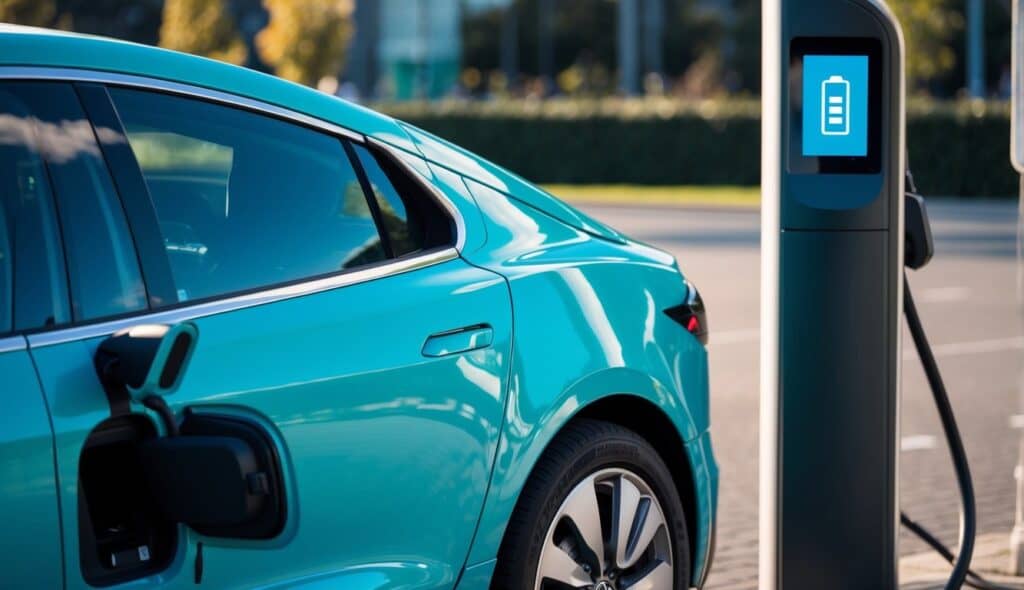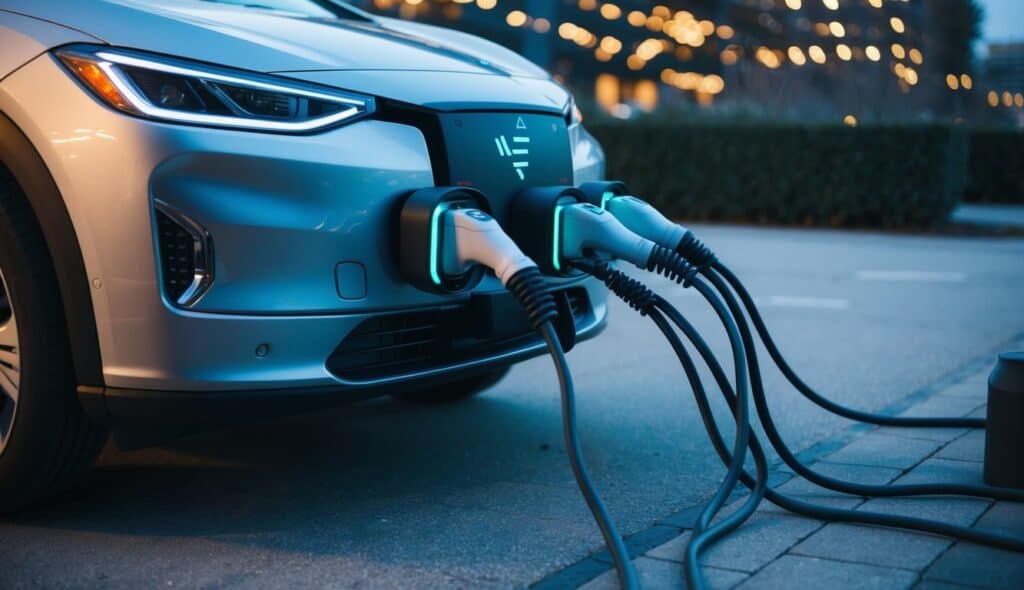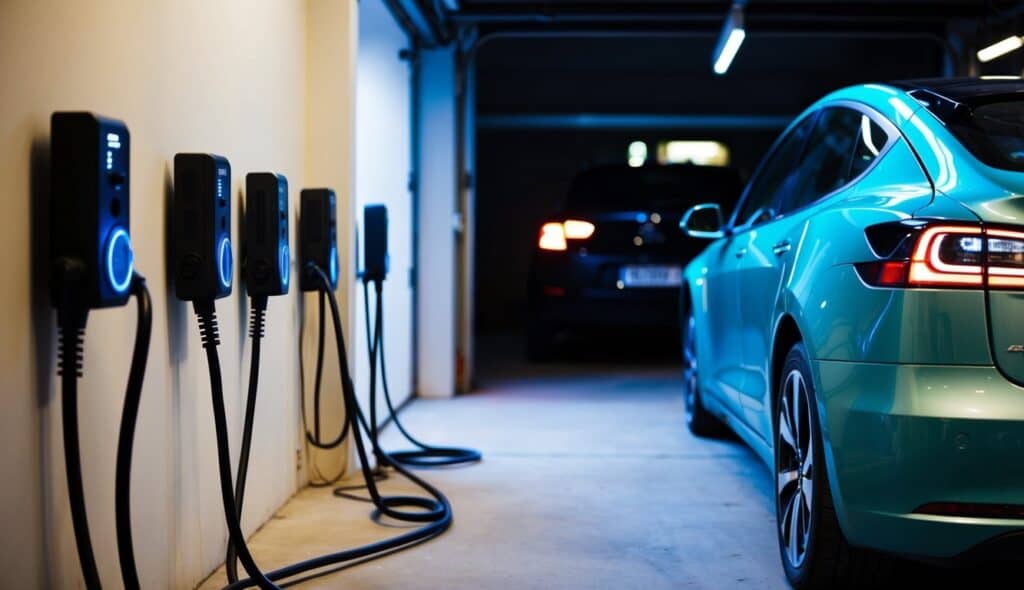Electric car owners often wonder why their batteries seem to drain faster than expected. This common issue can be frustrating, but understanding the causes can help drivers maximize their EV’s range and efficiency. Electric car battery drain is influenced by factors like driving speed, climate control use, and external temperatures.
Many people don’t realize that high-speed driving uses more energy than cruising at lower speeds. Additionally, heating and cooling the car’s cabin puts a significant strain on the battery. In colder weather, batteries work harder to maintain their charge, which can lead to faster depletion. Accessories like heated seats and entertainment systems also consume power, contributing to quicker battery drain.
Driving habits play a big role in battery life. Frequent acceleration and braking use more energy than steady driving. Hilly terrain also requires more power, causing the battery to drain more rapidly. By being aware of these factors, EV owners can make adjustments to extend their battery life and get the most out of each charge.
Understanding EV Battery Basics
Electric vehicle (EV) batteries are complex systems that power modern electric cars. They store and provide energy for the vehicle’s operation, playing a crucial role in performance and range.

Composition and Function
EV batteries are made up of many small cells. These cells contain chemicals that store and release energy. The most common type is lithium-ion.
When charged, the battery stores electrical energy. As the car runs, this energy turns into power for the motor. The battery also helps with other car functions like lights and air conditioning.
EV batteries are different from regular car batteries. They’re bigger and can store more energy. This lets electric cars drive longer distances before needing a recharge.
Factors Affecting Battery Life
Several things can impact how long an EV battery lasts. Temperature is a big one. Very hot or cold weather can make the battery work harder.
How you drive matters too. Fast starts and stops use more power. Driving at high speeds for a long time can drain the battery faster.
The way you charge your EV is important. Frequent fast charging can wear out the battery over time. Regular, slower charging is often better for battery health.
Age also affects battery life. Like all batteries, EV batteries slowly lose capacity over years of use. But most last for many years before needing replacement.
Common Causes of Rapid Battery Drain in Electric Cars
Electric car batteries can lose charge quickly for several reasons. These include weather conditions, how you drive, charging habits, and use of car features.
Extreme Temperatures Impact
Cold and hot weather can drain EV batteries fast. In cold temps, the battery works harder to warm up and power the car. This uses more energy.
Heat also affects battery life. Hot weather can make the battery work harder to stay cool. This uses up charge.
To help, park in garages or shaded areas when possible. Use pre-conditioning to warm up or cool down the car while it’s still plugged in.
Influence of Driving Habits
How you drive affects battery life. Fast acceleration and high speeds use more power. This drains the battery quicker.
Frequent short trips can also be a problem. The battery doesn’t have time to warm up fully. This makes it less efficient.
To save power, drive at steady speeds. Use cruise control on highways. Plan longer trips when possible.
Regenerative braking helps charge the battery as you slow down. Use this feature to extend range.
Impact of Charging Patterns
How you charge your EV matters. Always charging to 100% can stress the battery over time. This may lead to faster drain.
Using fast chargers too often can also affect battery health. They generate more heat, which can degrade the battery.
For daily use, charge to about 80%. Only charge fully for long trips. Use slower home charging when possible. This is gentler on the battery.
Accessory Usage and Parasitic Drain
Car features like heating, air conditioning, and infotainment systems use power. Running these a lot can drain the battery faster.
Some drain happens even when the car is off. This is called parasitic drain. It comes from systems that stay on, like security features.
To save power, use climate control wisely. Turn off unnecessary features when not needed. Check that all systems are off when you park.
Consider using seat heaters instead of cabin heat in winter. They use less energy.
Technical Issues Leading to Battery Drain
Electric car batteries can drain faster due to several technical problems. These issues often relate to the battery itself, the electrical system, or connections between components.

Degradation of the Battery Over Time
Electric car batteries lose capacity as they age. This natural process happens slowly but steadily. Older batteries hold less charge and drain more quickly than new ones.
Heat exposure speeds up battery wear. Parking in hot areas or frequent fast charging can harm battery health. Cold weather also reduces range temporarily.
Some cars show battery health on the dashboard. This helps track degradation over time. When capacity drops below 70-80%, the battery may need replacement.
Electrical System Malfunctions
Faulty electrical parts can drain the battery faster than normal. Bad sensors, computers, or wiring may pull extra power even when the car is off.
A broken charging system might not fully charge the battery. This leaves less energy for driving. Loose or damaged cables can also cause power loss.
Strange noises, dim lights, or warning lights on the dash can point to electrical problems. Getting these fixed quickly helps prevent further battery drain.
Corroded Battery Connections
Corrosion on battery terminals cuts power flow. This makes the battery work harder and drain faster. White, green, or blue crusty buildup is a sign of corrosion.
Dirt and moisture cause corrosion over time. Regular cleaning prevents this issue. A mix of baking soda and water removes corrosion safely.
Loose connections also waste energy. Tightening terminal clamps improves power transfer. Some car parts stores offer free battery checks to spot these problems early.
Diagnostic Methods for Battery Drain
Electric car batteries can drain unexpectedly fast. Two key tools help find the cause: multimeters and parasitic draw tests. These methods pinpoint issues draining your battery.
Multimeter Usage
A multimeter is crucial for checking battery health. Set it to voltage mode and connect it to the battery terminals. A healthy electric car battery should read 12.6 volts or higher when fully charged. Lower readings may indicate a problem.
Next, use the multimeter to measure current draw. Set it to the amperage setting. Disconnect the negative battery cable and connect the multimeter between the cable and battery terminal. This shows how much power the car uses when off.
Normal draw is under 50 milliamps (0.05 amps). Higher readings point to a parasitic drain.
Conducting a Parasitic Draw Test
A parasitic draw test finds what’s draining your battery. Start by disconnecting the negative battery cable. Set your multimeter to measure amps and connect it between the cable and battery terminal.
Wait for the reading to stabilize. If it’s over 50 milliamps, you have a drain. To find the source, remove fuses one by one. When the draw drops, you’ve found the circuit causing the problem.
Check that circuit for shorts or malfunctioning components. Common culprits include interior lights, audio systems, and faulty relays. Fix or replace the problem part to stop the drain.
Best Practices for Battery Maintenance and Longevity
Taking good care of your electric car battery is key to keeping it running well for a long time. Let’s look at some important steps you can take to maintain your battery and make it last longer.

Regular Check-Ups and Maintenance
Get your car checked by a professional often. They can spot small issues before they become big problems.
Keep your battery clean. Dirt and grime can harm it over time. Wipe it down gently with a damp cloth when needed.
Watch out for extreme temperatures. Very hot or cold weather can hurt your battery. Park in shade or a garage when possible.
Pay attention to warning lights on your dashboard. They can tell you if something is wrong with your battery.
Optimal Charging Techniques
Don’t let your battery get too low or too full. Try to keep it between 20% and 80% charged.
Avoid fast charging all the time. It can be hard on your battery. Use it only when you really need to.
Set up timed charging if you can. Charge your car when electricity rates are lower, usually at night.
Don’t leave your car plugged in for days if it’s already full. This can stress the battery.
Use the right kind of charger for your car. The wrong one could damage your battery.
Frequently Asked Questions
Electric car owners often have questions about battery drain. Understanding the factors that affect battery life can help maximize range and performance.
What factors contribute to fast battery depletion in electric vehicles?
Driving at high speeds uses more energy. Rapid acceleration and frequent braking also drain the battery faster. Extreme temperatures, both hot and cold, can reduce range. Using power-hungry features like climate control and heated seats impacts battery life too.
How does the use of heating or air conditioning affect electric car battery life?
Climate control systems are big energy users in electric cars. Running the heater or air conditioner can reduce driving range by 10-20%. In very hot or cold weather, the impact may be even greater.
What are the common causes of battery drain when an electric car is parked?
Some battery drain while parked is normal. This powers systems like alarm and keyless entry. Faulty electrical components can cause excess drain. Software updates may also use battery power when the car is off.
How can I extend the battery life of my electric car while driving?
Use eco-driving techniques like smooth acceleration. Plan routes to avoid steep hills when possible. Remove excess weight from the car. Use seat heaters instead of cabin heat when practical.
What steps can be taken to prevent an electric car battery from draining quickly?
Park in temperature-controlled areas when possible. Use pre-conditioning while plugged in. Avoid letting the battery sit at very high or low charge levels for long periods. Keep tires properly inflated for better efficiency.
How can I troubleshoot the cause of rapid battery drain in my electric car?
Check for software updates that may improve efficiency. Have a technician inspect for faulty components drawing excess power. Monitor energy use with the car’s built-in tools. Compare your range to expected values for your model.
Conclusion
Electric car batteries can drain faster than expected for several reasons. Extreme temperatures, both hot and cold, can affect battery performance. Using climate control systems like air conditioning or heating draws extra power.
Aggressive driving with rapid acceleration and high speeds reduces range. Carrying heavy loads or driving up steep hills requires more energy. Regular use of infotainment systems and other electronics puts additional strain on the battery.
Proper maintenance is key to maximizing battery life and range. Drivers should monitor tire pressure, remove unnecessary weight, and plan efficient routes. Charging habits also impact battery health over time.
Understanding these factors allows EV owners to adjust their habits. Small changes can lead to noticeable improvements in range. With smart practices, drivers can get the most out of their electric vehicle’s battery capacity.
Regular software updates from manufacturers may also help optimize battery performance. As EV technology advances, future models will likely offer even better range and efficiency.
You may also like:

Hi, I’m Marybeth, an electric car enthusiast living in New York in the USA. As the owner of electriccartalks.com, I love sharing my knowledge on EV tips, battery maintenance, and charging solutions. As a proud Tesla owner, I blend my personal experiences with professional insights to offer valuable information to fellow EV enthusiasts. Through my articles, I aim to empower others to make informed decisions about their electric vehicles. Read more